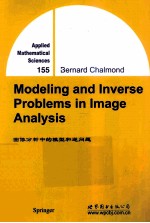

图像分析中的模型和逆问题PDF电子书下载
- 电子书积分:12 积分如何计算积分?
- 作 者:(法)查蒙德著
- 出 版 社:北京/西安:世界图书出版公司
- 出版年份:2014
- ISBN:9787510070198
- 页数:312 页
1 Introduction 1
1.1 About Modeling 3
1.1.1 Bayesian Approach 3
1.1.2 Inverse Problem 8
1.1.3 Energy-Based Formulation 10
1.1.4 Models 11
1.2 Structure of the Book 14
Ⅰ Spline Models 21
2 Nonparametric Spline Models 23
2.1 Definition 23
2.2 Optimization 26
2.2.1 Bending Spline 26
2.2.2 Spline Under Tension 28
2.2.3 Robustness 31
2.3 Bayesian Interpretation 34
2.4 Choice of Regularization Parameter 36
2.5 Approximation Using a Surface 39
2.5.1 L-Spline Surface 40
2.5.2 Quadratic Energy 43
2.5.3 Finite Element Optimization 46
3 Parametric Spline Models 51
3.1 Representation on a Basis of B-Splines 51
3.1.1 Approximation Spline 53
3.1.2 Construction of B-Splines 54
3.2 Extensions 57
3.2.1 Multidimensional Case 57
3.2.2 Heteroscedasticity 62
3.3 High-Dimensional Splines 67
3.3.1 Revealing Directions 68
3.3.2 Projection Pursuit Regression 70
4 Auto-Associative Models 75
4.1 Analysis of Multidimensional Data 75
4.1.1 A Classical Approach 76
4.1.2 Toward an Alternative Approach 80
4.2 Auto-Associative Composite Models 82
4.2.1 Model and Algorithm 82
4.2.2 Properties 84
4.3 Projection Pursuit and Spline Smoothing 86
4.3.1 Proiection Index 87
4.3.2 Spline Smoothing 90
4.4 Illustration 93
Ⅱ Markov Models 97
5 Fundamental Aspects 99
5.1 Definitions 99
5.1.1 Finite Markov Fields 100
5.1.2 Gibbs Fields 101
5.2 Markov-Gibbs Equivalence 103
5.3 Examples 106
5.3.1 Bending Energy 106
5.3.2 Bernoulli Energy 107
5.3.3 Gaussian Energy 108
5.4 Consistency Problem 109
6 Bayesian Estimation 113
6.1 Principle 113
6.2 Cost Functions 118
6.2.1 Cost Function Examples 119
6.2.2 Calculation Problems 121
7 Simulation and Optimization 123
7.1 Simulation 124
7.1.1 Homogeneous Markov Chain 124
7.1.2 Metropolis Dynamic 125
7.1.3 Simulated Gibbs Distribution 127
7.2 Stochastic Optimization 130
7.3 Probabilistic Aspects 134
7.4 Deterministic Optimization 138
7.4.1 ICM Algorithm 138
7.4.2 Relaxation Algorithms 141
8 Parameter Estimation 147
8.1 Complete Data 148
8.1.1 Maximum Likelihood 149
8.1.2 Maximum Pseudolikelihood 150
8.1.3 Logistic Estimation 153
8.2 Incomplete Data 156
8.2.1 Maximum Likelihood 157
8.2.2 Gibbsian EM Algorithm 161
8.2.3 Bayesian Calibration 170
Ⅲ Modeling in Action 175
9 Model-Building 177
9.1 Multiple Spline Approximation 177
9.1.1 Choice of Data and Image Characteristics 179
9.1.2 Definition of the Hidden Field 181
9.1.3 Building an Energy 183
9.2 Markov Modeling Methodology 185
9.2.1 Details for Implementation 185
10 Degradation in Imaging 189
10.1 Denoising 190
10.1.1 Models with Explicit Discontinuities 190
10.1.2 Models with Implicit Discontinuities 198
10.2 Deblurring 201
10.2.1 A Particularly Ill-Posed Problem 202
10.2.2 Model with Implicit Discontinuities 204
10.3 Scatter 205
10.3.1 Direct Problem 206
10.3.2 Inverse Problem 211
10.4 Sensitivity Functions and Image Fusion 216
10.4.1 A Restoration Problem 217
10.4.2 Transfer Function Estimation 221
10.4.3 Estimation of Stained Transfer Function 224
11 Detection of Filamentary Entities 227
11.1 Valley Detection Principle 228
11.1.1 Definitions 228
11.1.2 Bayes-Markov Formulation 230
11.2 Building the Prior Energy 231
11.2.1 Detection Term 231
11.2.2 Regularization Term 234
11.3 Optimization 236
11.4 Extension to the Case of an Image Pair 239
12 Reconstruction and Projections 243
12.1 Projection Model 243
12.1.1 Transmission Tomography 243
12.1.2 Emission Tomography 246
12.2 Regularized Reconstruction 247
12.2.1 Regularization with Explicit Discontinuities 248
12.2.2 Three-Dimensional Reconstruction 252
12.3 Reconstruction with a Single View 256
12.3.1 Generalized Cylinder 256
12.3.2 Training the Deformations 259
12.3.3 Reconstruction in the Presence of Occlusion 261
13 Matching 269
13.1 Template and Hidden Outline 270
13.1.1 Rigid Transformations 270
13.1.2 Spline Model of a Template 272
13.2 Elastic Deformations 276
13.2.1 Continuous Random Fields 276
13.2.2 Probabilistic Aspects 282
References 289
Author Index 301
Subject Index 305
- 《水面舰艇编队作战运筹分析》谭安胜著 2009
- 《社会学与人类生活 社会问题解析 第11版》(美)James M. Henslin(詹姆斯·M. 汉斯林) 2019
- 《强制执行前沿与热点问题》陈兴责编;乔宇 2020
- 《分析化学》陈怀侠主编 2019
- 《党员干部理论学习培训教材 理论热点问题党员干部学习辅导》(中国)胡磊 2018
- 《影响葡萄和葡萄酒中酚类特征的因素分析》朱磊 2019
- 《仪器分析技术 第2版》曹国庆 2018
- 《全国普通高等中医药院校药学类专业十三五规划教材 第二轮规划教材 分析化学实验 第2版》池玉梅 2018
- 《Power BI数据清洗与可视化交互式分析》陈剑 2020
- 《行测资料分析》李永新主编 2019
- 《中风偏瘫 脑萎缩 痴呆 最新治疗原则与方法》孙作东著 2004
- 《水面舰艇编队作战运筹分析》谭安胜著 2009
- 《王蒙文集 新版 35 评点《红楼梦》 上》王蒙著 2020
- 《TED说话的力量 世界优秀演讲者的口才秘诀》(坦桑)阿卡什·P.卡里亚著 2019
- 《燕堂夜话》蒋忠和著 2019
- 《经久》静水边著 2019
- 《魔法销售台词》(美)埃尔默·惠勒著 2019
- 《微表情密码》(波)卡西亚·韦佐夫斯基,(波)帕特里克·韦佐夫斯基著 2019
- 《看书琐记与作文秘诀》鲁迅著 2019
- 《酒国》莫言著 2019
- 《TED说话的力量 世界优秀演讲者的口才秘诀》(坦桑)阿卡什·P.卡里亚著 2019
- 《小手画出大世界 恐龙世界》登亚编绘 2008
- 《近代世界史文献丛编 19》王强主编 2017
- 《课堂上听不到的历史传奇 世界政治军事名人 初中版》顾跃忠等编著 2015
- 《指向核心素养 北京十一学校名师教学设计 英语 七年级 上 配人教版》周志英总主编 2019
- 《365奇趣英语乐园 世界民间故事》爱思得图书国际企业 2018
- 《近代世界史文献丛编 36》王强主编 2017
- 《北京生态环境保护》《北京环境保护丛书》编委会编著 2018
- 《近代世界史文献丛编 11》王强主编 2017
- 《近代世界史文献丛编 18》王强主编 2017
